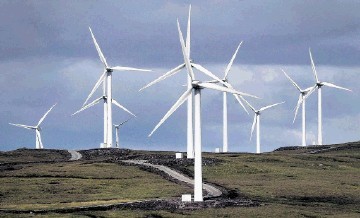
Researchers at blue chip US seat of learning, Stanford University say there is plenty of wind available to supply half to several times the world’s total energy needs within the next two decades.
Partnered by a team from the University of Delaware, they developed a highly-sophisticated weather model that shows there is plenty of harvestable wind over land and near to shore to achieve this, even after accounting for reductions in wind speed caused by turbines.
The new paper contradicts two earlier studies that said wind potential falls far short of the aggressive goal because each turbine steals too much wind energy from other turbines, and that turbines introduce harmful climate consequences that would negate some of the positive aspects of renewable wind energy.
The new US model provides a more sophisticated look than previously possible by separating winds in the atmosphere into hypothetical boxes stacked atop and beside one another.
Each box has its own wind speed and weather. In their model, the joint team exposed individual turbines to winds from several boxes at once, a degree of resolution earlier global models did not match.
In their study, Mark Z. Jacobson, a professor of civil and environmental engineering at Stanford and Cristina Archer, an associate professor of geography and physical ocean science and engineering at Delaware.
In their study, they adapted the three-dimensional, atmosphere-ocean-land computer model known as GATOR-GCMOM to calculate the theoretical maximum wind power potential on the planet taking into account wind reduction by turbines.
But there’s a catch as their model assumed wind turbines could be installed anywhere and everywhere, without regard to societal, environmental, climatic or economic considerations.
“Modelling the climate consequences of wind turbines is complex science,” said Jacobson. “This software allows that level of detail for the first time.”
While there is huge potential in the wind, they admitted that at some point, however, the return on building new turbines plateaus, reaching a level in which no additional energy can be extracted even with the installation of more turbines.
“Each turbine reduces the amount of energy available for others,” Archer said. The reduction, however, becomes significant only when large numbers of turbines are installed, many more than would ever be needed.
“And that’s the point that was very important for us to find,” Archer said.
The researchers have dubbed this point the saturation wind power potential.
That potential, they say, is more than 250 terawatts if we could place an army of 100m-tall wind turbines across the entire land and water of planet Earth.
Alternatively, if we place them only on land (minus Antarctica) and along the coastal ocean there is still some 80 terawatts available – about seven times the total power demand of all civilisation.
Hypothetical turbines operating in the jet streams six miles up in the atmosphere could extract as much as an additional 380 terawatts.
“We’re not saying, ‘Put turbines everywhere’, but we have shown that there is no fundamental barrier to obtaining half or even several times the world’s all-purpose power from wind by 2030. The potential is there, if we can build enough turbines,” said Jacobson.
Knowing that the potential exists, the researchers turned their attention to how many turbines would be needed to meet half the world’s power demand – about 5.75 terawatts – in a 2030 clean-energy economy.
To get there, they explored various scenarios of what they call the fixed wind power potential – the maximum power that can be extracted using a specific number of wind turbines.
Archer and Jacobson showed that 4million 5-megawatt turbines operating at a height of 100m could supply as much 7.5 terawatts of power – way more than half the world’s all-purpose power demand – without significant negative climate impact.
“We have a long way to go. Today, we have installed a little over 1% of the wind power needed,” said Jacobson.
In terms of surface area, Jacobson and Archer say they would site half the 4million turbines over water. The remaining 2million would require a little more than one-half of one percent of the Earth’s land surface.
Rather than put all the turbines in a single location, Archer and Jacobson say it is best and most efficient to spread out wind farms in high-wind sites across the globe – the Gobi Desert, the American plains and the Sahara, for example.